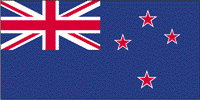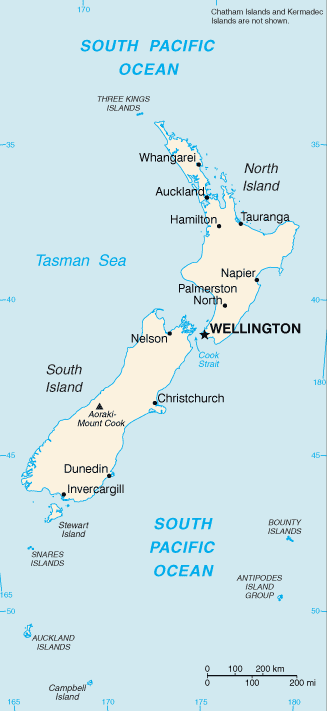Topics Covered
Welcome to New Zealand
Overview of Resources
Metals
Industrial Minerals and Gemstones
Fossil Fuels
Investment
Sources
Welcome to New Zealand
New Zealand is an island nation located in the southwest Pacific Ocean to the southeast of Australia. The total area of the country is 267,710 km2 with a population of 4,327,944 as of July 2012. Its climatic condition is mostly temperate.
After years of colonization, New Zealand slowly emerged as an independent economy that is more self-reliant and moving towards advanced industrialization with a free market policy. Despite the economic downturn and subsequent recession in 2009, the country’s economy managed a 1.7% growth in 2010 and 2% growth the following year. The country’s GDP was $123.8 billion as of 2011.
New Zealand’s natural resources include gold, silver, natural gas, iron ore, coal, and limestone. Despite having a variety of mineral resources, the production of the country’s mineral industry is lesser than that of its neighbor Australia. The total exports of New Zealand were valued at $32.2 billion and total imports were valued at US$31.4 billion in 2010. Australia continues to be New Zealand’s main import and export trading partner.
 |
The national flag of New Zealand
Image Credit: CIA Factbook |
Overview of Resources
The metallic mineral occurrences in New Zealand include silver, gold, iron, chromium, copper, gallium, lead, lithium, magnesite, manganese, mercury, molybdenum, nickel, platinum-group metals, rare earths, tin, antimony, bauxite, zinc, beryllium, titanium, tungsten, and uranium. However, only gold, iron, and silver were produced in 2010. Production of other metallic minerals would be undertaken by the country only if it is economically feasible and prices are favorable.

The map of New Zealand. Image Credit: CIA Factbook
Metals
The only aluminum producer in New Zealand is New Zealand Aluminum Smelters Ltd., whose production increased to 343,335 Mt in 2010 from 271,902 t the previous year.
The major players in gold production are Newmont Mining Corp. of USA and OceanaGold Corp. The Macraes gold projects conducted by OceanaGold include the Frasers underground mine and the Macraes open pit mine on the east coast of the South Island, and a 1-million-Mt/yr processing plant and the Reefton open pit mine on the west coast.
A joint venture by Newmont Mining and Glass Earth Gold Ltd. conducted exploration operations in 2010 to locate gold prospects in the southwest of Whangamata and at the Wharekirponga prospect.
New Zealand Steel Ltd. located at Glenbrook is the only steel producer in the country. The company’s iron-making plant has a production capacity of 650,000 Mt/yr.
Industrial Minerals and Gemstones
The major players in New Zealand’s cement industry are Golden Bay Cement and Holcim New Zealand Ltd. There are plans to replace the old cement plant at Weston, near Oamatu, with a newly constructed modern technology plant by Holcim New Zealand Ltd. so as to increase production capacity and minimize emissions.
Fossil Fuels
New Zealand’s coal resources are abundant, amounting to about 15 billion Mt (Gt); however, only 8.6 Gt has been economically recoverable. As of 2010, five underground and 16 opencast mines were operating in the country. The government owns nearly 50% of the country’s coal resources.
The various types of coal available in New Zealand and their location are as follows:
- Bituminous coal - West Coast region of the South Island
- Sub-bituminous coal - Waikato region of the North Island, Otago, Southland, and West Coast regions of the South Island.
- Lignite resources - Otago and Southland regions of the South Island
Pike River Coal Ltd. completed the Pike River coal mine construction activities in 2010 at the west coast of the South Island. The company constructed a 2,300-m adit to access the recoverable resource amounting to 18 Mt of low-ash coking coal.Natural gas and oil are produced from 19 fields spread around the Taranaki Basin.
New Zealand’s oil production statistics for 2010 is provided below:
- Maari field accounted for 31.1%
- Pohokura field accounted for 21.9%
- Tui field accounted for 18.0%
- Maui field accounted for 10.0%
- Others accounted for 19.0%
Investment
According to reports, the Government of New Zealand has recently decided to remove some of the existing restrictions on public areas, which could be potential mineral exploration zones leading to a significant contribution to the country’s economy. The government has also extended the tax exemption for mining exploration companies up to December 31, 2014.
In July this year, 28 miners were trapped underground due to a fire in a gold mine owned by Newmont. Although the miners were safely rescued, it brought mining safety issues to the forefront and the mining sector has now urged the government to upgrade its mining practices to world-class standards.
Several constraints that are slowing down the development of the mining sector in New Zealand are as follows:
- Environmental awareness
- Ecological sensitivity of the country
- Location of the country, which is far from major industrial markets
Experts feel that the future of New Zealand’s mining industry will largely depend on the government’s ability to find effective solutions for the above issues.
Disclaimer: The Author of this article does not imply any investment recommendation and some content is speculative in nature. The Author is not affiliated in any way with any companies mentioned and all statistical information is publically available.
Sources
Disclaimer: The views expressed here are those of the author expressed in their private capacity and do not necessarily represent the views of AZoM.com Limited T/A AZoNetwork the owner and operator of this website. This disclaimer forms part of the Terms and conditions of use of this website.